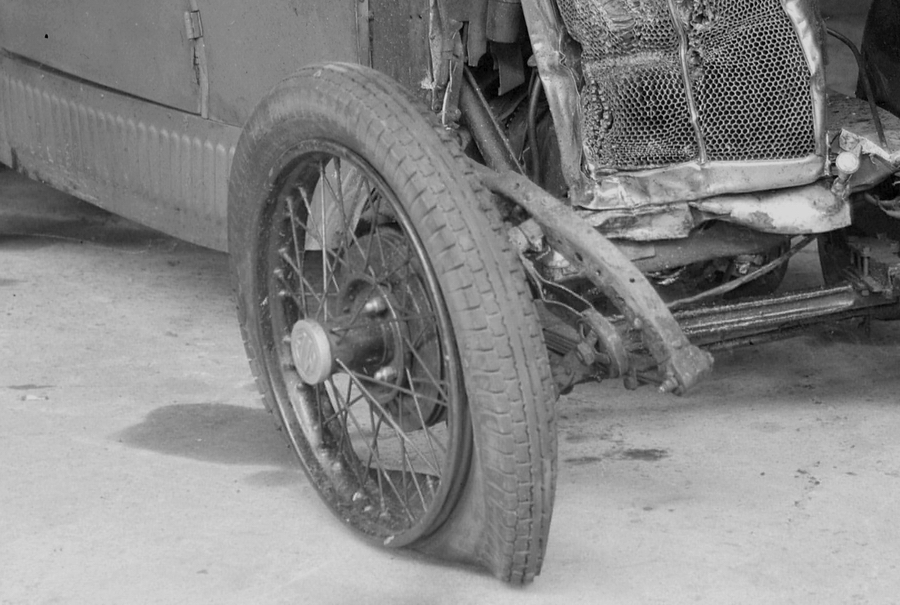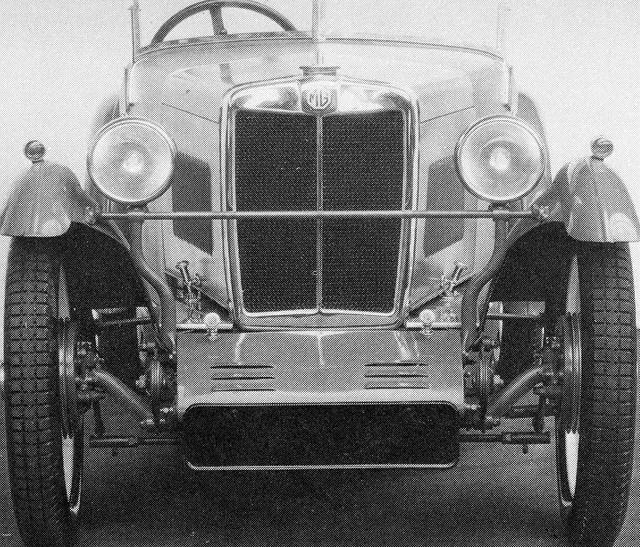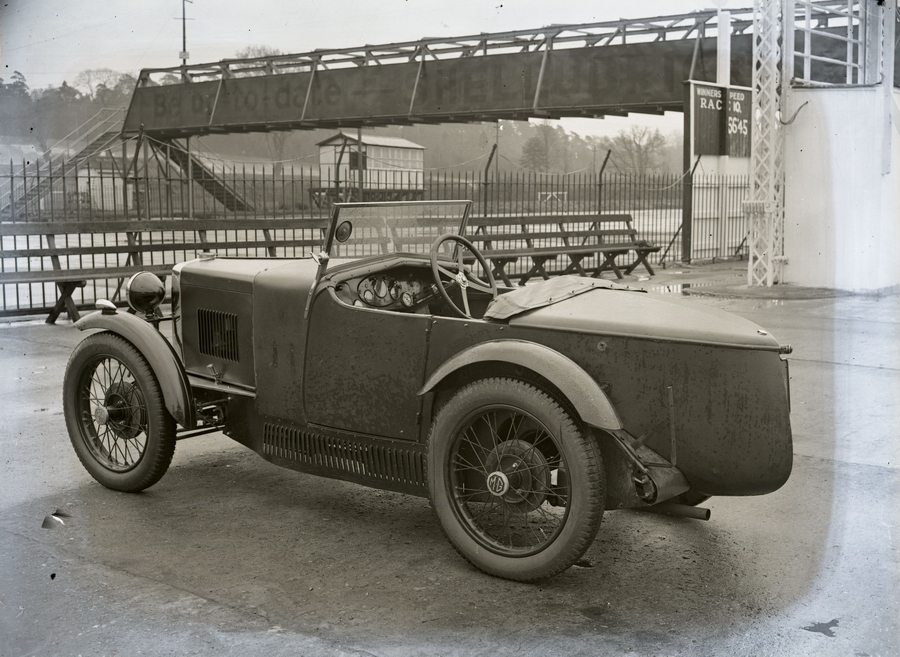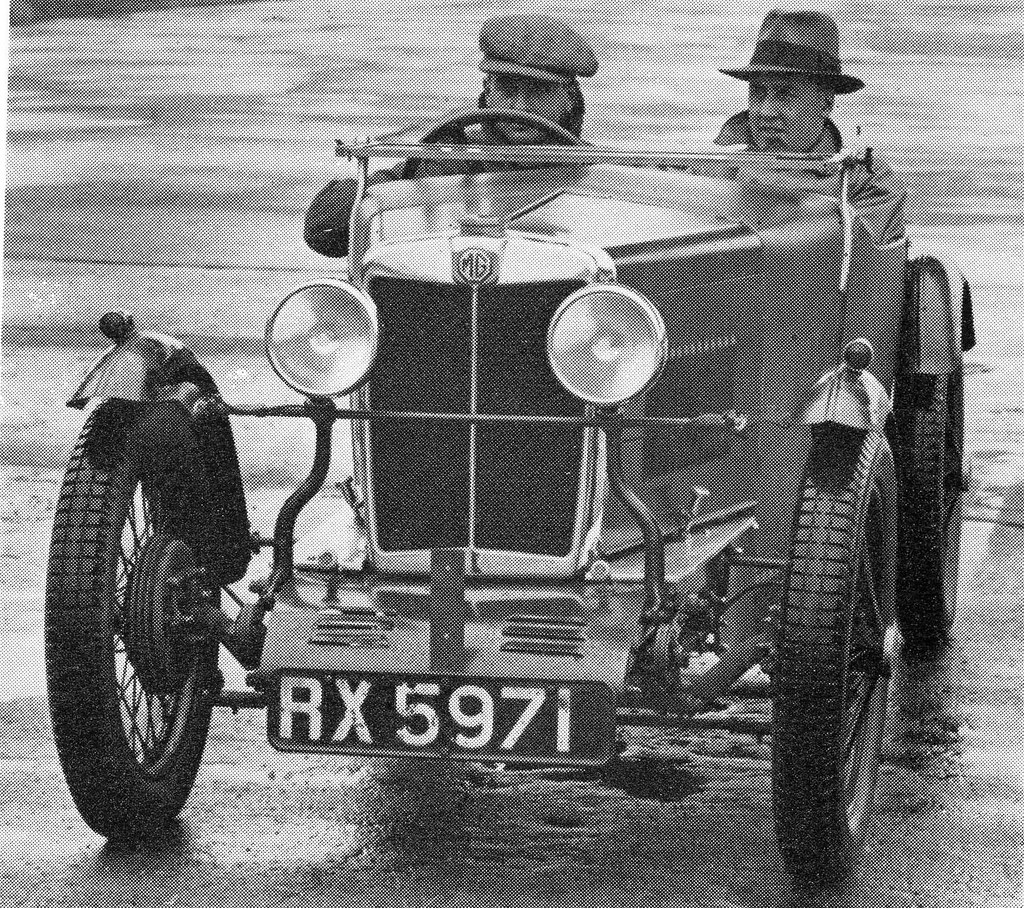Finish on M type finned brake drums.
Moderators: Ian Grace, Will Grace
Finish on M type finned brake drums.
What was the original finish on these drums?
In theory should the fins be matt black or polished?
My A level Physics was a long while ago!
In theory should the fins be matt black or polished?
My A level Physics was a long while ago!
Re: Finish on M type finned brake drums.
I think they were painted - see the period image below. As for theory, my Physics A level was also many moons ago, but I seem to remember that black would radiate more heat than a bare aluminium surface. But I think the primary heat loss from the M brake drums is caused by conduction to the air rather than radiation - and the amount of heat conducted is proportional to the surface area in contact with the cooling air, not the surface finish (fin-ish - ha!).

-
Sam Christie
- Posts: 186
- Joined: Mon Nov 20, 2006 10:37 am
Re: Finish on M type finned brake drums.
My money is in general on black (see the Austin Harris pictures taken at Brooklands) but there are pictures of one period car with what look like polished aluminium brake drum fins.I suspect the aluminium sumps were painted black too but they look so much nicer in a 'silver' finish that even the purists loose interest and change the subject when evidence of black paint is produced.




Re: Finish on M type finned brake drums.
I have seen a factory photo where the fins are clearly polished - you can even see the reflection of the spokes. Interestingly, it would seem the axles and backplates were not painted black.
Ian
Ian
Last edited by ian judd on Thu Sep 01, 2011 7:16 am, edited 1 time in total.
-
Sam Christie
- Posts: 186
- Joined: Mon Nov 20, 2006 10:37 am
Re: Finish on M type finned brake drums.
I think the car below is fairly normal/average -

But the one below has a non-standard wheels colour and polished aluminium fins (in which the spokes are reflected).I believe this is a 1929 car but with improved brakes and front hinge doors. Other shots show it still has the early Lucas instrument panel - somebody,I recall, asserted it was prepared for a motor show.


But the one below has a non-standard wheels colour and polished aluminium fins (in which the spokes are reflected).I believe this is a 1929 car but with improved brakes and front hinge doors. Other shots show it still has the early Lucas instrument panel - somebody,I recall, asserted it was prepared for a motor show.

Last edited by Sam Christie on Sat Dec 17, 2011 12:51 pm, edited 5 times in total.
-
Sam Christie
- Posts: 186
- Joined: Mon Nov 20, 2006 10:37 am
Re: Finish on M type finned brake drums.
The picture below suggests body colour brake drums and.....could those be bare aluminium fins? It would be interesting to see this in much higher resolution.

I confess, I don't know.

I confess, I don't know.
Re: Finish on M type finned brake drums.
Just love those period pictures 
Regards,
Halbe
Regards,
Halbe
Re: Finish on M type finned brake drums.
If they were generally painted the same colour as the body then perhaps the axle and drums were painted as an assembled unit. Sam's suggestion that they could have been the same colour as the body certainly seems likely. Still, buyers who had seen a show car with polished drums may have wanted them too. Quite a few of my drums were painted at one time but how can you tell when?
Ian
Ian
Re: Finish on M type finned brake drums.
From a manufacturing point of view, it is hard to believe that someone had the job of carefully masking off the fins prior to spraying the drums. And what about the steel flange on the inside? That had to be painted too.
Re the car with white (?) wheels it is also hard to believe that someone would have gone to the trouble of re-hinging the doors on a 1929 model to the front, which would have necessitated a near complete re-fabric. I'm not sure that the 1929 spec. came in all at once, and that the presence of a Lucas panel makes this a 1929 model. Morris would have had tons of these (and other Lucas stock) as they continued to be fitted to the OHC Minors for some time. Whether or not Kimber's gang drew parts from Morris stores or had their own stock, they would have used up what they had on the shop floor before switching to Rotax equipment.
I have seen this debate crop up several times over the years, and I believe the conclusion was usually that the transition from 1929 season/Oxford spec. to 1930 season/Abingdon spec. was very much a phased event with plenty of 'transition' cars with odd combinations of the features of what we now consider to be 1929 and 1930 models.
A parallel debate focused on whether the chassis were drawn from Morris, but the creation of the OHC Minor Genome proved conclusively that the two chassis series were entirely separate.
All of this makes M Types particularly interesting!
Here's another shot of RX 5971 at Brooklands. Here, among all sorts of other enigmas, we have a rear-hinged doors and Rotax panel!

Re the car with white (?) wheels it is also hard to believe that someone would have gone to the trouble of re-hinging the doors on a 1929 model to the front, which would have necessitated a near complete re-fabric. I'm not sure that the 1929 spec. came in all at once, and that the presence of a Lucas panel makes this a 1929 model. Morris would have had tons of these (and other Lucas stock) as they continued to be fitted to the OHC Minors for some time. Whether or not Kimber's gang drew parts from Morris stores or had their own stock, they would have used up what they had on the shop floor before switching to Rotax equipment.
I have seen this debate crop up several times over the years, and I believe the conclusion was usually that the transition from 1929 season/Oxford spec. to 1930 season/Abingdon spec. was very much a phased event with plenty of 'transition' cars with odd combinations of the features of what we now consider to be 1929 and 1930 models.
A parallel debate focused on whether the chassis were drawn from Morris, but the creation of the OHC Minor Genome proved conclusively that the two chassis series were entirely separate.
All of this makes M Types particularly interesting!
Here's another shot of RX 5971 at Brooklands. Here, among all sorts of other enigmas, we have a rear-hinged doors and Rotax panel!
Re: Finish on M type finned brake drums.
Another great picture that I don't think I've seen before. I am particularly pleased to see such a clear picture of a number plate bracket - (a spare fitted for competition numbers?) - which is normally obscured by the plate and/or bodywork. It also shows what appears to be evidence of having had a spare wheel bracket on the side of the scuttle.
I wonder what the other instruments were.
Ian
I wonder what the other instruments were.
Ian
Re: Finish on M type finned brake drums.
Ian,
I will e-mail you a much higher res version of this and the other photo of this car at Brooklands (the front-on view above).
I have to 'dumb down' pics to 900 pixels to fit on the forum pages.
Ian
I will e-mail you a much higher res version of this and the other photo of this car at Brooklands (the front-on view above).
I have to 'dumb down' pics to 900 pixels to fit on the forum pages.
Ian
-
Sam Christie
- Posts: 186
- Joined: Mon Nov 20, 2006 10:37 am
Re: Finish on M type finned brake drums.
I think the M-type at Brooklands is a development car and so it has a selection of mixed parts and signs of use. It is in several ways like a prototype for the 12/12 cars.The holes in the scuttle and the single hole in the side of the tail might relate to testing a Brooklands exhaust (but not with this bonnet of course). As well as the fold flat screen the car has reduced guards like a 12/12. It has what looks like a rev counter to the left of the steering column and something else to the left of the instrument panel .The advance retard is mounted in the manner of the cars with Rotax instrument panels.
I wonder when RX 5971 was registered. I notice that 'RX' seems to prefix a number of non standard M-types including an experimental supercharged example RX 7206 and the famous Beggars Roost car RX 6795 (or was it standard?). Was 'RX' an Abingdon registration?
I wonder when RX 5971 was registered. I notice that 'RX' seems to prefix a number of non standard M-types including an experimental supercharged example RX 7206 and the famous Beggars Roost car RX 6795 (or was it standard?). Was 'RX' an Abingdon registration?
Last edited by Sam Christie on Sat Sep 03, 2011 8:34 am, edited 1 time in total.
Re: Finish on M type finned brake drums.
Thia car was written up in the 2008 VMR Yearbook:
"Seen here in front of the Clubhouse at Brooklands, this Berkshire-registered M Type RX 5971 was an interesting example built to 12/12 specification, including fold flat windscreen, reversed headlamp supports, abbreviated wings and stronger wheel spokes, but with an early 1929 standard body with rear-hinged doors. Registered in late 1929, might this have been an early experimental prototype for the 12/12 race in May?"
"Seen here in front of the Clubhouse at Brooklands, this Berkshire-registered M Type RX 5971 was an interesting example built to 12/12 specification, including fold flat windscreen, reversed headlamp supports, abbreviated wings and stronger wheel spokes, but with an early 1929 standard body with rear-hinged doors. Registered in late 1929, might this have been an early experimental prototype for the 12/12 race in May?"
-
Sam Christie
- Posts: 186
- Joined: Mon Nov 20, 2006 10:37 am
Re: Finish on M type finned brake drums.
Perhaps I absorbed more of the 2008 Yearbook than I was aware but not the Berkshire registration bit.Not sure about the spokes, perhaps Tony Margel might comment?


-
Sam Christie
- Posts: 186
- Joined: Mon Nov 20, 2006 10:37 am
Re: Finish on M type finned brake drums.
Sorry to have drifted so far from brake drums ... but......As an aside to the Abingdon/Berkshire registration observation I found this contribution by George Wilder archived on the MG Triple-M site ........
".........RX was one of the registrations that the Berkshire County Council was allocated to issue.
Where was Abingdon in those days ? - well in Berkshire. So any car registered by the factory would use a Berkshire registration.
Historian to C 0256 registration RX 8591.
George
PS Abingdon was placed in Oxfordshire for adminstrative purposes sometime in the late 70s early 80s just as the DVLA was being formed....."
".........RX was one of the registrations that the Berkshire County Council was allocated to issue.
Where was Abingdon in those days ? - well in Berkshire. So any car registered by the factory would use a Berkshire registration.
Historian to C 0256 registration RX 8591.
George
PS Abingdon was placed in Oxfordshire for adminstrative purposes sometime in the late 70s early 80s just as the DVLA was being formed....."